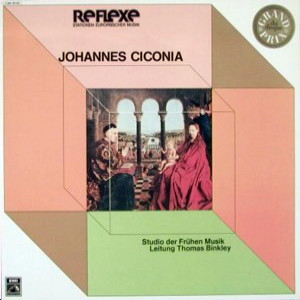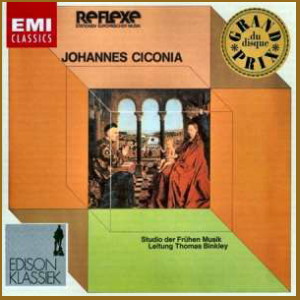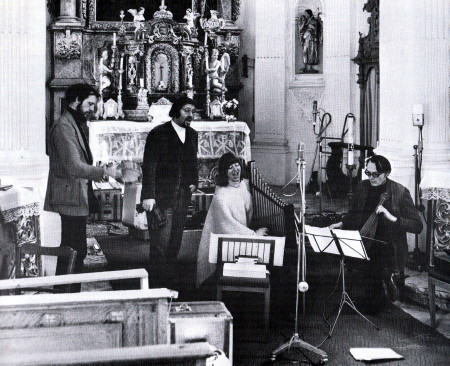 |
1 LP -
1C 063-30 102 - (p) 1972
|

|
1 CD - 8
26468 2 - (c) 2000
|
 |
1 CD -
CDM 7 63442 2 - (c) 1991
|
|
| Johannes
Ciconia (1335-1411) - Geistiche &
Weltliche Werke |
|
|
|
|
|
| ITALIENISCHE WERKE |
|
|
- Una panthera
- Mezzosopran, Tenor, Fidel
|
5' 37" |
|
- Chi nel servir
- Mezzosopran, 2 Fideln
|
3' 07" |
|
- Lizadra donna
- Altus, Fidel, Sackbut
|
4' 07" |
|
- Per quella
strada - Mezzosopran,
Tenor
|
3' 43" |
|
| -
O rosa bella - Tenor,
Fidel, Laute |
5' 29" |
|
|
|
|
| FRANZÖSISCHE WERKE |
|
|
- Le ray au
soleyl - Mezzosopran,
Tenor, Sackbut
|
1' 45" |
|
- Sus un'
fontayne - Mezzosopran,
Fidel, Laute
|
5' 53" |
|
- Aler m'en veus
- Mezzosopran, Tenor
|
3' 49" |
|
| LATEINISCHE WERKE |
|
|
- Albane misse
celitus - Sopran,
Mezzosopran, Sackbut I + II
|
2' 41" |
|
- Gloria - Chor
|
3' 41" |
|
- Credo - Chor
|
5' 39" |
|
|
|
|
STUDIO DER FRÜHEN
MUSIK / Thomas Binkley, Leitung
|
|
-
Andrea von Ramm, Mezzosopran
|
|
| -
Willard Cobb, Tenor |
|
| -
Richard Levitt, Altus |
|
| -
Sterling Jones, Fidel, Lira |
|
| -
Johannes Fink, Fidel |
|
| -
Thomas Binkley, Laute, Sackbut |
|
| -
Lucy Craig, Sopran |
|
| -
Klaus Renk, Sackbut |
|
|
|
|
|
Luogo
e data di registrazione |
|
Séon-Studio,
München (Germania) - 21-23 &
27-29 dicembre 1970 |
|
|
Registrazione: live /
studio |
|
studio |
|
|
Producer / Engineer |
|
Gerd
Berg / Dieter Tomsen
|
|
|
Prima Edizione LP |
|
EMI
Electrola "Reflexe" - 1C 063-30
102 - (1 lp) - durata 46' 20" -
(p) 1972 - Analogico |
|
|
Prima Edizione CD |
|
EMI
"Classics" - CDM 7 63442 2 - (1
cd) - durata 46' 20" - (c) 1991 -
ADD |
|
|
Edizione CD |
|
EMI
"Classics" - 8 26468 2 - (1 cd) -
durata 46' 20" - (c) 2000 - ADD |
|
|
Note |
|
- |
|
|
|
|
|
 JOHANNES
CICONIA JOHANNES
CICONIA
The first thing to be
established, however, is his
place in his own time, and the
school to which he belonged.
There is no documentary
evidence to show whether he
was “Flemish” or “Dutch“. He
came from the state or the
diocese, perhaps even from the
city, of Liège,
for it was there, at the
Collegiate Church of St John
the Evangelist, that he
received his earliest musical
training.
His father, “Jean Ciwagne“,
was a furrier; it was due to
one of his customers, Nicolas
de Bessa of Avignon, that
Johannes and his brother,
Guillemus del Ciwagne, came to
Avignon in 1348. In 1350 we
find the two young men in the
service of Aliénore de
Turenne, whose sister, Cécilie
de Comminges, had a close
relationship with Pope Clement
VI. Aliénore’s
influence with the Pope
obtained a canonry at St John
the Evangelist's at Liège for
her intimate friend Johannes,
and another at the Church of
Saint Denis for Guillaume.
At this time three men, who
played an important part in
the musical life of France,
generally lived at Avignon:
the theorist Jan de Muris, to
whom the Pope had entrusted
the task of revising the
calendar; Philippe de Vitry,
the author of the treatise
entitled Ars Nova, at
that time in the service of
John, a son of the King of
France and French Ambassador
to the Papal Court; and
Guillaume de Machaut, who had
been obliged by the death of
his master, John of
Luxembourg, at the battle of
Crécy in 1346, to find either
a new patron or a benefice.
Guillaume, the younger of the
“Ciwagne“ brothers, returned
to Liège
a few years later, but
Johannes stayed to make a
career for himself at Avignon.
He entered the service of
Cardinal d’Albornoz, whom he
accompanied to Italy,
where he was sent to regain
the Papal States for the Pope,
with four other men from Liège in
his suite. Travelling from
Lombardy to Florence, from
Milan to Padua, from Orvieto
to Viterbo and from Bologna to
Cesena, Ciconia became
acquainted with the most
important Italian
cities in which music was
being decisively influenced by
a new concept of art, very
different from that which he
had been taught in his youth
at Liège
and later at Avignon. The
death of Cardinal d’Albornoz
in 1367 inspired Ciconia to
compose the ballad Con lacrime
bagnando il viso, which
was sung again at Padua on the
occasion of the death of
Francesco II
des Novello de Carrara, who
was murdered when Padua was
captured by the Venetians in
1405. This song was so moving
that more than one organ
arrangement of it is to be
found in the Buxheim Book of
Organ Music of the end of the
fifteenth century.
When his protector died,
Ciconia returned to Liège,
but not without first trying
to find a new patron in some
North italian court,
especially at Padua; he had
made influential friends there
when he was in the senrvice
of Cardinal d’Albornoz, who in
1367 had obtained the title of
“Vicar General" of the italian
Realm for Prince Francesco
Carrara as a reward for his
support of the Papal policy. It is
probable that the madrigal Per
quella strada lactea del
cielo (Along the milky
way in the heavens) was
composed to celebrate this
occasion, for the words, which
are so similar to the Triomphi
of Petrarch who was then in
the service of the court of
Padua (Vedeva un carro
andar tutto abrassato -Il saw
a flaming chariot pass by),
are a direct reference to the
Carrara coat of arms, which
show a flaming chariot
travelling through a starlit
sky. Curiously enough,
incidentally, a picture of a
flaming chariot moving in
space is also found in a
manuscript of Petrarch’s works
that is preserved in the
Bibliotheque Nationale in
Paris.
No dout he also stayed for a
short time at the court of
Galeazzo Visconti at Milan,
for the canon Le ray au
soleyl (The ray of the
sun) is a reference to the
arms of Galeazzo and his wife,
Isabel of Valois, “the gentle
turtle dove", and to the
Duke’s motto, “A bon droit“.
Isabel died giving birth to a
son in 1371, so the
composition of the canon, and
Ciconia’s stay at Padua,
however short it may have
been, can be dated slightly
earlier.
A documentary reference to his
presence among the clergy of
St. John the Evangelist’s
shows that he was back at Liège in
1372, and he
remained there, unless he had
occasion to travel, until the
end of the century. The
circumstances of his life
there were pleasant; although
nominally a cleric, he married
the daughter of Jacque d’Heur,
a well known citizen of Liège,
and he had enough leisure to
give profound thought to his
art and to the problem of
combining the intellectual
structure of the French Ars
Nova with the
sensitivity characteristic of
Italian music, particularly of
that produced in the North
Italian cities of Padua, Milan
and Verona. At this time he
also evolved his own
individual style and described
it in a treatise entitled Nova
Musica, which he later
took with him to Italy. Most of
the works that he composed at
Liège
inthe last quarter of the
fourteenth century were lost
in the fire that destroyed the
city in 1468, in the time of
Charles the Bold. Many,
however, were saved by being
taken to Italy,
especially the Masses (that is
to say the closely related Et
in terra and Patrem
in the tradition of Avignon),
the similarity of which is
obvious owing to the use of a
single canto fermo
(Regina gloriosa), the overall
structure, the liturgical
tenor and the technique of the
proportions.
Yet he must have travelled
frequently during this time.
His absences from Liège
were recorded by the clergy of
St .John’s, and sometimes even
his emoluments were paid to a
colleague. This was especially
the case in 1396 and 1398,
when the organist Gilla signed
receipts for the salary of the
absent Ciconia.
Where did he goto? To Avignon,
whose Pope he, like many Liègeois,
recognised as the true Pope?
The song Sus une fontaine,
en remirant, the musical
style of which was described
by Philipottus de Caserta as
“are subtilior", is as
reminiscent of Petrarch’s
“fountain” as of the three
motives, musical as well as
literary (“en remirant“, “en
attendant", “de ma dolour“)
which show a direct connection
with the three songs composed
by Philipottus during his stay
at the Papal court in 1370.
The political situation
deteriorated round about 1400
and 1401, when Liège was
again attacked by the plague.
Ciconia’s name appears for the
last time in the archives of
St John the Evangelist’s in
1401, the year in which,
thanks to the Archpriest
Zabarella of Padua,
he was made a prebendary of
the Cathedral at Padua, which
enabled him to live there.
This honour was bestowed upon
him as a reward for his
compositions in honour of the
city. Of
these, O felix templum
was composed for the
consecration ceremonies of the
restored cathedral, and
dedicated to Stefano Carrara
in 1400. Yet it is not until
1402 that his name is found in
the account books of the
cathedral at Padua, which he
was never to leave again.
He had left his native
country, but not without
composing a moving song of
farewell: Aler mens veux.
"I wish
to goto a foreign land,
because pity is dead; to you,
dear lady, for vvhom I yearn
day and night..." It was a
farewell to his native land at
a time when there was no
more pity in the world (Prince
John of Bavaria was surnamed
“the Pitiless“), and to the
wife he loved whom he was
never to see alive again... He
later used this song, written
in French ballade from, as the
setting of a Latin poem, O
beatum incendium. It is
a song in praise of Christ in
the form of a Litany: “Oh fire
of ecstasy, burning desire,
sweet fount of refreshment“;
it is the Son of God whose
praises Ciconia is singing in
his poem, which is as full of
yearning as his farewell to
his native land; the new world
in which he had decided to
live was the Church.
From then on he stayed at
Padua Cathedral, not only as a
priest but as musical
director. There he finished
writing his treatise, Nova
Musica, one chapter of
which he expanded in more
learned form, no doubt for the
use of his pupils the young
singers of Padua; he issued it
as a separate work entitled De
Proportionibus, and
dedicated it to his dear
“brother” Johannes Gasparo,
the choir master of Vicenza
Cathedral. He acted as an
examiner when the candidates
for the Doctorate of the
University of Padua defended
their theses, and was present
at the examination of a well
known theorist, Prosdocimo de
Beldemandi. He wrote motets
and Masses for Padua
Cathedral; he produced one
more composition in honour of
his protector, Zabarella, who
in the meantime had been
raised to the purple; he wrote
Masses, but he did not forget
the world and offered musical
homage to two famous cities:
Lucca, in honour of which he
wrote Una panthera in
compania di Marte (the
panther and Mars are the coat
of arms of the city of Lucca),
and for Venice, “splendeur du
monde“, a song with which to
welcome Petro Marcello,
the Bishop of Padua, in 1409.
It is
difficult to say with
certainty when he wrote his
famous italian Ballads. Some,
indeed, can be dated by their
italian ars nova
style, and so were presumably
composed some time before the
last phase of his life;
others, on the other hand,
show a more recherché
style, are as French as they
are Italian in structure, and
still have some traces of the
“ars subtilior“.
Possibly written during his
last years, they include Lizadra
donna, Chi nel
servir antico, and the
most famous of all, O rosa
bella, which was later
appropriated by Dunstable.
This ballad is still also to
be found in the books of organ
music of the end of the
fifteenth century.
Johannes Ciconia’s name
appears for the last time in
the account books of Padua
Cathedral on the 15th of
December 1411. He must
therefore have died between
the 15th and 25th of December,
which, at that time, was the
first day of the new year -
1412. Still known and admired
at the time of the Council of
Constance in 1417, he was
forgotten by musicians, and it
was not until the twentieth
century that his songs were
heard again.
Suzanne
Clerxc
(Translation:
Geoffrey Waltkins)
|
|
|
EMI Electrola
"Reflexe"
|
|
|
|

